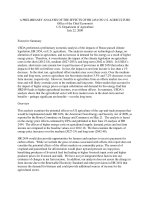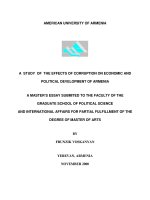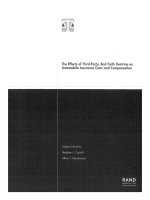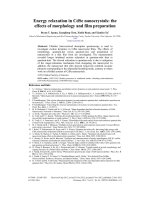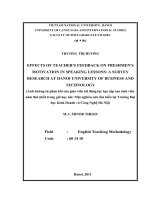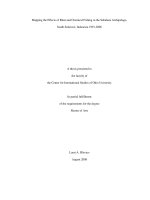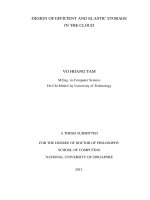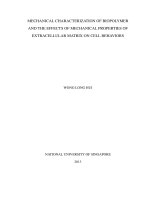Effects of elastic foundation and the Poisson’s ratio ( ) v v z = on the nonlinear buckling and postbuckling behaviors of imperfect FGM plates subjected to mechanical loads
Bạn đang xem bản rút gọn của tài liệu. Xem và tải ngay bản đầy đủ của tài liệu tại đây (240.59 KB, 15 trang )
<span class='text_page_counter'>(1)</span><div class='page_container' data-page=1>
226
Effects of elastic foundation and the Poisson’s ratio
<i>v</i>
=
<i>v z</i>
( )
on the nonlinear buckling and postbuckling behaviors
of imperfect FGM plates subjected to mechanical loads
Pham Hong Cong
*<i>VNU University of Engineering and Technology </i>
Received 11 May 2012, received in revised form 20 May 2012
<b>Abstract: This paper presents an analytical approach to investigate effects of elastic foundation </b>
and the Poisson’s ratio <i>v</i>=<i>v z</i>( ) on the nonlinear buckling behavior of imperfect FGM plates,
subjected to mechanical loads. Material properties are assumed to be temperature independent, and
graded in the thickness direction according to a power law distribution in terms of volume
fractions of constituents. Equilibrium and compatibility equations are derived by using classical
plate theory taking into account geometrical nonlinearity, initial geometrical imperfection and
elastic foundation with Pasternak model. Galerkin method is used to determine explicit
expressions of buckling loads and postbuckling paths. Analysis is carried out to assess the effects
of material, geometrical, elastic foundation parameters on the stability of FGM plates.
<i>Keywords:</i> Buckling and postbuckling, Functionally graded material, Plate, Elastic foundations,
Poisson’s ratio <i>v</i>=<i>v z</i>( ).
<b>1. Introduction</b>∗∗∗∗
Due to high performance is heat resistance capacity and excellent characteristics in comparison
with conventional composites, Functionally Graded Materials (FGMs) which are microscopically
composites and composed from mixture of metal and ceramic constituents have attracted considerable
attention recent years. By continuously and gradually varying the volume fraction of constituent
materials through a specific direction, FGMs are capable of withstanding ultrahigh temperature
environments and extremely large thermal gradients. Therefore, these novel materials are chosen to
use in structure components of aircraft, aerospace vehicles, nuclear plants as well as various
temperature shielding structures widely used in industries. Buckling and postbuckling behaviors of
FGM structures under different types of loading are important for practical applications and have
received considerable interest. Eslami and his co-workers used analytical approach, classical and
higher order plate theories in conjunction with adjacent equilibrium criterion to investigate the
_______
∗
Tel.:+84 1649 589 562
</div>
<span class='text_page_counter'>(2)</span><div class='page_container' data-page=2>
buckling of FGM plates with and without imperfection under mechanical and thermal loads [3,8,9].
According to this direction, Lanhe [10] also employed first order shear deformation theory to obtain
closed-form relations of critical buckling temperatures for simply supported FGM plates. Zhao et al.
[14] analyzed the mechanical and thermal buckling of FGM plates using element-free Ritz method.
Liew et al. [15,16] used the higher order shear deformation theory in conjunction with differential
quadrature method to investigate the postbuckling of pure and hybrid FGM plates with and without
imperfection on the point of view that buckling only occurs for fully clamped FGM plates. The
postbuckling behavior of pure and hybrid FGM plates under the combination of various loads were
also treated by Shen [17,18] using two-step perturbation technique taking temperature dependence of
material properties into consideration. Recently, Lee et al. [19] made of use element-free Ritz method
to analyze the postbuckling of FGM plates subjected to compressive and thermal loads.
The components of structures widely used in aircraft, reusable space transportation vehicles and
civil engineering are usually supported by an elastic foundation. Therefore, it is necessary to account
for effects of elastic foundation for a better understanding of the postbuckling behavior of plates and
shells. Librescu and Lin have extended previous works [20] to consider the postbuckling behavior of
flat and curved laminated composite panels resting on Winkler elastic foundations [20]. In spite of
practical importance and increasing use of FGM structures, investigation on FGM plates and shells
supported by elastic media are limited in number. The bending behavior of FGM plates resting on
Pasternak type foundation has been studied by Huang et al. [21] using state space method, Zenkour
[22] using analytical method and by Shen and Wang [23] making use of asymptotic perturbation
technique. To the best of authors’ knowledge, there is no analytical studies have been reported in the
literature on the postbuckling of thick FGM plates resting on elastic foundations.In [11], the authors
Dao Van Dung and Nguyen Thi Nga have studied the stability of the composite FGM plate when
( )
<i>v</i>=<i>v z</i> and <i>E</i>=<i>E z</i>( )(without elastic foundation). In [12], the author Do Nam has studied the
stability of the FGM plate on the elastic foundation with classical plate theory, in [6] the authors
Nguyen Dinh Duc and Hoang Van Tung have studied postbuckling of the high order shear deformable
FGM plates on elastic foundation, but these studies assume <i>E</i>=<i>E z</i>( ) and <i>v</i>=<i>c</i>ons<i>t</i>.
The aim of the paper proposed is of studying the nonlinear stability of FGM plate on the elastic
foundation under the effect of the load in the case both elastic modules are variable <i>v</i>=<i>v z</i>( ) and
( )
<i>E</i>=<i>E z</i> , the study of the effect of the initial imperfect shape, proportion metal-ceramic, and the
elastic foundation parameters and the geometric parameters on the nonlinear stability of the FGM plate
<b>2. FGM plates on elastic foundations </b>
</div>
<span class='text_page_counter'>(3)</span><div class='page_container' data-page=3>
x
y
z
h
a
b
shear layer
<i><b> </b></i>
<i><b> Fig.1.Geometry and coordinatr system of an FGM plate on elastic foundation </b></i>The volume fractions of constituents are assumed to vary through the thickness according to the
following power law distribution
( )
2
,
( )
1
( )
2
<i>N</i>
<i>m</i> <i>c</i> <i>m</i>
<i>z</i>
<i>h</i>
<i>V z</i>
<i>V z</i>
<i>V z</i>
<i>h</i>
+
=
= −
(1)
where
<i>N</i>
is volume fraction index (0
≤
<i>N</i>
< ∞
). Effective propertiesPr
<i>eff</i> of FGM panel aredetermined by linear rule of mixture as
Pr ( )
<i>eff</i><i>z</i>
=
Pr
<i>m</i><i>V z</i>
<i>m</i>( )
+
Pr
<i>c</i><i>V z</i>
<i>c</i>( )
(2)where
Pr
denotes a temperature independent material property, and subscripts<i>m</i>
and<i>c</i>
stand for themetal and ceramic constituents, respectively.
Specific expressions of modulus of elasticity
<i>E</i>
, Poisson ratioν
the coefficient of thermalexpansion
α
are obtained by substituting Eq. (1) into Eq. (2) as [11]2
( ) ( )
2
<i>N</i>
<i>N</i>
<i>m</i> <i>c</i> <i>m</i> <i>m</i> <i>cm</i>
<i>z</i> <i>h</i>
<i>E</i> <i>E z</i> <i>E</i> <i>E</i> <i>E</i> <i>E</i> <i>E r</i>
<i>h</i>
+
= = + − <sub></sub> <sub></sub> = +
<sub> (3)</sub>
1
1
2
( ) ( )
2
<i>N</i>
<i>N</i>
<i>m</i> <i>c</i> <i>m</i> <i>m</i> <i>cm</i>
<i>z</i> <i>h</i>
<i>z</i> <i>r</i>
<i>h</i>
ν ν
= =ν
+ν
−ν
<sub></sub> + <sub></sub> =ν
+ν
Where
1
2
;
;
;
0;
0
2
<i>cm</i> <i>c</i> <i>m</i> <i>cm</i> <i>c</i> <i>m</i>
<i>z</i>
<i>h</i>
<i>E</i>
<i>E</i>
<i>E r</i>
<i>N</i>
<i>N</i>
<i>h</i>
ν
ν
ν
+
=
−
=
=
−
≥
≥
(4)
It is evident from Eqs. (3), (4) that the upper surface of the plate (
<i>z</i>
= −
<i>h</i>
/ 2
) is ceramic-rich,while the lower surface (
<i>z</i>
=
<i>h</i>
/ 2
) is metal-rich, and the percentage of ceramic constituent in thepanel is enhanced when
<i>N</i>
increases.</div>
<span class='text_page_counter'>(4)</span><div class='page_container' data-page=4>
where
∇ = ∂
2 2/
∂
<i>x</i>
2+ ∂
2/
∂
<i>y</i>
2,<i>w</i>
is the deflection of the plate,<i>k</i>
<sub>1</sub> is Winkler foundation modulusand
<i>k</i>
<sub>2</sub> is the shear layer foundation stiffness of Pasternak model.<i>2.1. Theoretical formulation </i>
For imperfect plates, the strain components on the reference surface with the geometrical
nonlinearity in von Karman sense, are [1]
(
)
(
)
2 <sub>*</sub>
0 , , , ,
2 <sub>*</sub>
0 , , , ,
* *
0 , , , , , , , ,
w
/ 2 w w ;
w
/ 2 w w ;
w w
w w
w w
<i>x</i> <i>x</i> <i>x</i> <i>x</i> <i>x</i>
<i>y</i> <i>y</i> <i>y</i> <i>y</i> <i>y</i>
<i>xy</i> <i>y</i> <i>x</i> <i>x</i> <i>y</i> <i>y</i> <i>x</i> <i>x</i> <i>y</i>
<i>u</i>
<i>v</i>
<i>u</i>
<i>v</i>
ε
ε
γ
=
+
+
=
+
+
=
+
+
+
+
(6)
Where <i>u</i>=<i>u x y v</i>( , ), =<i>v x y</i>( , ) and <i>w</i>=<i>w x y</i>( , )are displacements along <i>x y</i>, and <i>z</i>
respectively; <i>w</i>*=<i>w x y</i>*( , ) denotes an initial imperfections of plate. The quantity w* is assumed
small.
The strains across the plate thickness at a distance <i>z</i> from the mid-plane are [1]
0 0 0
, , ,
; ; 2
w , w , w
<i>x</i> <i>x</i> <i>x</i> <i>y</i> <i>y</i> <i>y</i> <i>xy</i> <i>xy</i> <i>xy</i>
<i>x</i> <i>xx</i> <i>y</i> <i>yy</i> <i>xy</i> <i>xy</i>
<i>zk</i> <i>zk</i> <i>zk</i>
<i>k</i> <i>k</i> <i>k</i>
ε
=ε
+ε
=ε
+γ
=γ
+= − = − = − (7)
Hooke law for an FGM plate is defined as
2
( , ) ( , ) ( , ) (1 ) (1,1)
1
2(1 )
<i>x</i> <i>y</i> <i>x</i> <i>y</i> <i>y</i> <i>x</i>
<i>xy</i> <i>xy</i>
<i>E</i>
<i>v</i> <i>v</i> <i>T</i>
<i>v</i>
<i>E</i>
<i>v</i>
σ σ
ε ε
ε ε
α
σ
γ
= <sub></sub> + − + ∆ <sub></sub>
−
=
+
(8)
where we assume that the plate is subjected to a uniform temperature rise i.e. ∆<i>T</i> is a constant. So,
the force and moment resultants are expressed a
(
)
(
)
/ 2
, ,
/ 2
/ 2
/ 2
( , , ) , ,
( , , ) , ,
<i>h</i>
<i>x</i> <i>y</i> <i>xy</i> <i>x</i> <i>y</i> <i>xy</i>
<i>h</i>
<i>h</i>
<i>x</i> <i>y</i> <i>xy</i> <i>x</i> <i>y</i> <i>xy</i>
<i>h</i>
<i>N</i> <i>N</i> <i>N</i> <i>dz</i>
<i>M</i> <i>M</i> <i>M</i> <i>zdz</i>
σ σ σ
σ σ σ
−
−
=
=
∫
∫
(9)
Substituting relations (3), (6) ÷ (8) into (9), after series of calculations, we have
(
)
(
)
( )
(
)
( )
10 20 0 20 10 0 11 21 21 11 1
30 0 31
11 21 0 21 11 0 12 22 22 12 2
31 0 32
, , ( , ) ( , ) ( , ) 1,1
2
, ( , ) ( , ) ( , ) ( , ) 1,1
2
<i>x</i> <i>y</i> <i>x</i> <i>y</i> <i>x</i> <i>y</i>
<i>xy</i> <i>xy</i> <i>xy</i>
<i>x</i> <i>y</i> <i>x</i> <i>y</i> <i>x</i> <i>y</i>
<i>xy</i> <i>xy</i> <i>xy</i>
<i>N</i> <i>N</i> <i>J</i> <i>J</i> <i>J</i> <i>J</i> <i>J</i> <i>J</i> <i>k</i> <i>J</i> <i>J</i> <i>k</i> <i>T</i>
<i>N</i> <i>J</i> <i>J k</i>
<i>M</i> <i>M</i> <i>J</i> <i>J</i> <i>J</i> <i>J</i> <i>J</i> <i>J</i> <i>k</i> <i>J</i> <i>J</i> <i>k</i> <i>T</i>
<i>M</i> <i>J</i> <i>J k</i>
</div>
<span class='text_page_counter'>(5)</span><div class='page_container' data-page=5>
ij( 1, 2, 3; 0,1, 2), 1, 2
<i>J i</i>= <i>j</i>=
φ φ
defined as follows
/ 2
1 2
/ 2
/ 2
2 2
/ 2
/ 2
3 1 2
/ 2
/ 2
1
/ 2
/ 2
2
/ 2
( )
;
1
( )
( ) ( )
;
1
( )
1
( )
1
(
)
2
1
( )
2
( ) ( )
;
1
( )
( ) ( )
1
( )
<i>h</i>
<i>j</i>
<i>j</i>
<i>h</i>
<i>h</i>
<i>j</i>
<i>j</i>
<i>h</i>
<i>h</i>
<i>j</i>
<i>j</i> <i>j</i> <i>j</i>
<i>h</i>
<i>h</i>
<i>h</i>
<i>h</i>
<i>h</i>
<i>E z</i>
<i>J</i>
<i>z dz</i>
<i>v z</i>
<i>E z v z</i>
<i>J</i>
<i>z dz</i>
<i>v z</i>
<i>E z</i>
<i>J</i>
<i>z dz</i>
<i>J</i>
<i>J</i>
<i>v z</i>
<i>E z</i>
<i>z</i>
<i>dz</i>
<i>v z</i>
<i>E z</i>
<i>z</i>
<i>zdz</i>
<i>v z</i>
α
φ
α
φ
−
−
−
−
−
=
−
=
−
=
=
−
+
= −
−
= −
−
∫
∫
∫
∫
∫
(11)
The equilibrium equations of a imperfect plate on elastic foundations are in the form [2÷4]:
, ,
, ,
*
, , , , ,
* * 2
, , , , 1 2
0
0
2
(
)
2
(
)
(
)
w+
w
0
<i>x x</i> <i>xy y</i>
<i>xy x</i> <i>y y</i>
<i>x xx</i> <i>xy xy</i> <i>y yy</i> <i>x</i> <i>xx</i> <i>xx</i>
<i>xy</i> <i>xy</i> <i>xy</i> <i>y</i> <i>yy</i> <i>yy</i>
<i>N</i>
<i>N</i>
<i>N</i>
<i>N</i>
<i>M</i>
<i>M</i>
<i>M</i>
<i>N w</i>
<i>w</i>
<i>N</i>
<i>w</i>
<i>w</i>
<i>N w</i>
<i>w</i>
<i>k</i>
<i>k</i>
+
=
+
=
+
+
+
+
+
+
+
+
−
∇
=
<sub>(12)</sub><sub> </sub>
We introduce Airy’s stress function <i>f</i> = <i>f x y</i>( , ) so that
, ; , ; ,
<i>x</i> <i>yy</i> <i>y</i> <i>xx</i> <i>xy</i> <i>xy</i>
<i>N</i> = <i>f</i> <i>N</i> = <i>f</i> <i>N</i> = −<i>f</i>
(13)
It is easy to see that the first two equations in (12) are automatically satisfied.
Substituting relations (13) in Eqs. (10), we obtain
0 1 10 , 20 , 2 , 3 , 4 1
0 1 10 , 20 , 2 , 3 , 4 1
0 31 , , 30
(
w
w
)
(
w
w
)
(2
w
) /
<i>x</i> <i>yy</i> <i>xx</i> <i>xx</i> <i>yy</i>
<i>y</i> <i>xx</i> <i>yy</i> <i>yy</i> <i>xx</i>
<i>xy</i> <i>xy</i> <i>xy</i>
<i>I J f</i>
<i>J f</i>
<i>I</i>
<i>I</i>
<i>I</i>
<i>T</i>
<i>I J f</i>
<i>J f</i>
<i>I</i>
<i>I</i>
<i>I</i>
<i>T</i>
<i>J</i>
<i>f</i>
<i>J</i>
ε
φ
ε
φ
γ
=
−
+
+
−
∆
=
−
+
+
−
∆
=
−
(13)
where
2 2
1 10 20 2 10 11 20 21
3 10 21 20 11 4 10 20
1/ (
),
,
<i>I</i>
<i>J</i>
<i>J</i>
<i>I</i>
<i>J J</i>
<i>J J</i>
<i>I</i>
<i>J J</i>
<i>J J</i>
<i>I</i>
<i>J</i>
<i>J</i>
=
−
=
−
=
−
=
−
<sub> (15) </sub>Substituting once again the expressions of Eq. (14) into the relations of internal moments <i>M</i><sub>ij</sub>in
(10) we obtain
1 , ( 11 20 21 10) 1 , ( 11 10 21 20) 1w, ( 11 2 21 3) 1w, ( 11 3 21 2) 12w, 22w
<i>x</i> <i>xx</i> <i>yy</i> <i>xx</i> <i>yy</i> <i>xx</i> <i>yy</i>
</div>
<span class='text_page_counter'>(6)</span><div class='page_container' data-page=6>
1 , ( 21 20 11 10) 1 , ( 21 10 11 20) 1w, ( 21 2 11 3) 1w, ( 21 3 11 2) 22w, 12w
<i>y</i> <i>xx</i> <i>yy</i> <i>xx</i> <i>yy</i> <i>xx</i> <i>yy</i>
<i>M</i> =<i>I f</i> −<i>J J</i> +<i>J J</i> +<i>I f</i> <i>J J</i> −<i>J J</i> +<i>I</i> <i>J I</i> +<i>J I</i> +<i>I</i> <i>J I</i> +<i>J I</i> −<i>J</i> −<i>J</i>
(
)
31
31 , , 32 ,
30
2 w 2 w
<i>xy</i> <i>xy</i> <i>xy</i> <i>xy</i>
<i>J</i>
<i>M</i> <i>J</i> <i>f</i> <i>J</i>
<i>J</i>
= − −
(16)
The substituting (16) into the third equation of (12) we have
4 4 * * * 2
1 2
w
,<i>yy</i>(w
,<i>xx</i>w ) 2
,<i>xx</i> ,<i>xy</i>(w
,<i>xy</i>w )
,<i>xy</i> ,<i>xx</i>(w
,<i>yy</i>w
,<i>yy</i>)
1w+
2w
0
<i>A</i>
∇
<i>f</i>
+
<i>A</i>
∇
+
<i>f</i>
+
−
<i>f</i>
+
+
<i>f</i>
+
−
<i>k</i>
<i>k</i>
∇
=
(17)
where
4 4 4
4
4
2
2 2 4<i>x</i>
<i>x y</i>
<i>y</i>
∂
∂
∂
∇ =
+
+
∂
∂
∂
1 1 3; 2 1( 11 2 21 3) 12
<i>A</i> =<i>I I A</i> =<i>I J I</i> +<i>J I</i> −<i>J</i>
The equation (17) includes two unknowns functions
w
and <i>f</i> , so it is necessary to find a secondequation relating to these two unknowns functions by using the compatible equation:
2
0 ,<i>x yy</i> 0 ,<i>y xx</i> 0<i>xy xy</i>,
(w
,<i>xy</i>)
w w
,<i>xx</i> ,<i>yy</i>ε
+
ε
−
γ
=
−
(18)
The substituting the above expressions of
ε
<sub>ij</sub> in (14) into Eqs. (18), we obtain(
)
24 4 * * *
3 w 4 w,<i>xy</i> w w,<i>xx</i> ,<i>yy</i> 2 ,<i>xy</i>w,<i>xy</i> w w,<i>xx</i> <i>yy</i> w,<i>yy</i>w,<i>xx</i> 0
<i>f</i> <i>A</i> <i>A</i> <i>w</i>
∇ + ∇ − <sub></sub> − + − − <sub></sub>=
<sub> (19) </sub>
in wich
3
3 4
10 1 10
1
;
<i>I</i>
<i>A</i> <i>A</i>
<i>J</i> <i>I J</i>
= =
The couple of Eqs. (17) and (19) are the governing equations used to investigate the nonlinear
stability of imperfect FGM plates with the Poisson’s Ratio
ν ν
= ( )<i>z</i> resting on elastic foundation.In the case w* =0, from (17) and (19) we obtain the basic stability equations for perfect FGM
plates.
<i>2.2. Boundary conditions and the solution of the problem</i>
Suppose that three cases boundary conditions for a rectangular plate will be considered follow as
[5, 6]:
<b>Case 1. The edges of plate are simply supported and freely movable (FM). The associated </b>
boundary conditions are:
x=0,<i>x</i>=<i>a</i>; w=<i>Mx</i> =<i>Nxy</i> =0;<i>Nx</i> =<i>Nx</i>0<sub> </sub> <sub> (20)</sub>
y=<i>0, y</i>=<i>b</i>
;
w=<i>My</i> =<i>Nxy</i> =0;<i>Ny</i> =<i>Ny</i>0<sub> </sub></div>
<span class='text_page_counter'>(7)</span><div class='page_container' data-page=7>
0
x=0,<i>x</i>=<i>a</i>; w =<i>Mx</i> =<i>u</i>=0;<i>Nx</i> =<i>Nx</i> <sub> (21)</sub>
y=0,<i>y</i>=<i>b</i>; w=<i>My</i> = =<i>v</i> 0;<i>Ny</i> =<i>Ny</i>0
<b>Case 3. The edges of plate are simply supported. Uniaxial edge loads are applied in the direction of </b>
the
<i>x</i>
-coordinate. The edges <i>x</i>=0,<i>x</i>
=
<i>a</i>
are considered freely movable, the remaining two edgesbeing unloaded and immovable. The boundary conditions, for this case, are
x=0,<i>x</i>=<i>a</i>; w=<i>Mx</i>=<i>Nxy</i> =0;<i>Nx</i> =<i>Nx</i>0<sub> (22)</sub>
y=0,<i>y</i>=<i>b</i>; w=<i>My</i> = =<i>v</i> 0;<i>Ny</i> =<i>Ny</i>0
where u, v are the displacement components x, y directions, respectively, <i>N<sub>xy</sub></i>,<i>M<sub>x</sub></i>,<i>M<sub>y</sub></i> are force
and moment resultants. Moreover,N , N<sub>x0</sub> <sub>y0</sub> are prebuckling force resultants in the direction
<i>x</i>
and<i>y</i> respectively, for Case 1 and the first of Case 3 or are fictitious compressive edge loads at
immovable edges (Case 2 and the second of Case 3).
Approximate solutions of basic equations (17) and (19) are assumed as [5, 6]:
*
1 2 3
2 2
4 0 0
w W sin sin
w sin sin
os2 os2 sin sin
1 1
os2 cos 2
2 2
<i>m</i> <i>n</i>
<i>m</i> <i>n</i>
<i>m</i> <i>n</i> <i>m</i> <i>n</i>
<i>m</i> <i>n</i> <i>x</i> <i>y</i>
<i>x</i> <i>y</i>
<i>h</i> <i>x</i> <i>y</i>
<i>f</i> <i>C c</i> <i>x</i> <i>C c</i> <i>y</i> <i>C</i> <i>x</i> <i>y</i>
<i>C c</i> <i>x</i> <i>y</i> <i>N y</i> <i>N x</i>
λ
δ
µ
λ
δ
λ
δ
λ
δ
λ
δ
=
=
= + + +
+ +
(23)
which fulfill exactly the out-of-plane boundary conditions and satisfy in-plane boundary conditions in
an average sense. Moreover,
λ
<i>m</i> =<i>m</i>π
/ ;<i>a</i>δ
<i>n</i> =<i>n</i>π
/ ; ,<i>b m n</i>=1, 2,... Wis amplitude of deflection andµ
is imperfection parameter (0≤µ
≤1).By substituting expression (23) into Eq. (19), we obtain
2
4
1 2
2
4
2 2
3 3
4
W
(W
2
)
32
W
(W
2
)
32
W
0
<i>n</i>
<i>m</i>
<i>m</i>
<i>n</i>
<i>A</i>
<i>h</i>
<i>C</i>
<i>A</i>
<i>h</i>
<i>C</i>
<i>C</i>
<i>A</i>
<i>C</i>
δ
µ
λ
λ
µ
δ
+
=
+
=
= −
=
<sub> (24) </sub></div>
<span class='text_page_counter'>(8)</span><div class='page_container' data-page=8>
(
)
(
2 2)
2 2 22 1 3 1 2
2 2 3
0 0
2 2 4 4
1 4 4
2
( ) W
32
( )(W ) W(W )
3
( )
16
W(W 2 ) W(W )(W 2 ) 0
3 8
<i>m</i> <i>n</i> <i>m</i> <i>n</i>
<i>m</i> <i>n</i>
<i>x</i> <i>m</i> <i>y</i> <i>n</i>
<i>m</i> <i>n</i> <i>m</i> <i>n</i>
<i>A</i> <i>A A</i> <i>k</i> <i>k</i>
<i>A</i>
<i>N</i> <i>N</i> <i>h</i> <i>h</i>
<i>ab</i>
<i>A A</i> <i>A</i>
<i>h</i> <i>h</i> <i>h</i>
<i>mn</i>
λ
δ
λ
δ
λ δ
λ
δ
µ
µ
λ δ
λ
δ
µ
µ
µ
π
<sub>−</sub> <sub>+</sub> <sub>−</sub> <sub>−</sub> <sub>+</sub> <sub>−</sub>
+ + − +
+
− + − + + =
(25)
where <i>m n</i>, are odd numbers. This equation will be used to analyze the buckling and postbuckling
behaviors of thick FGM plates under mechanical, thermal and thermomechanical loads on elastic
foundation.
<b>3. Nonlinear stability analysis FGM plate on elastic foundation </b>
<i>3.1. Mechanical stability analysis </i>
Consider a rectangular imperfect FGM plate being simply supported at its edges and freely
movable (Case. 1) and subjected to the in-plane compressive only loads <i>P<sub>x</sub></i> uniformly distributed
along the edges <i>x</i>=0,<i>a</i>. In this case, the prebuckling force resultants are given [7]
<i>Nx</i>0 = −<i>P h Nx</i> , <i>y</i>0 =0 (26)
Substituting this expression (26) into Eq. (25) we receive :
2 2 2 2 2 2 2 2 2
1 2 3 1 4
2 2 2 2 2 2 2 2 2 2
2 4 4 4
4
2 2 2
(
)
(
)
W
32
W
16
W(W 2 )
3
3
W
(W
)
(
)W(W 2 )
1
8
<i>a</i> <i>a</i> <i>a</i>
<i>x</i>
<i>a</i> <i>h</i> <i>h</i> <i>h</i> <i>h</i> <i>h</i>
<i>a</i>
<i>a</i> <i>h</i>
<i>D</i>
<i>B m</i>
<i>n</i>
<i>K DB</i>
<i>K D m B</i>
<i>n</i>
<i>A</i>
<i>n</i>
<i>A A n</i>
<i>P</i>
<i>B B m</i>
<i>B m</i>
<i>B m</i>
<i>B m</i>
<i>B m</i>
<i>A</i>
<i>m B</i>
<i>n</i>
<i>B B m</i>
π
µ
π
µ
µ
π
µ
<sub>+</sub>
<sub>+</sub>
<sub>+</sub>
=
+
+
+
+
+
+
+
+
+
(27)
where :
3
1 2 4
1 3 2 2 3 4 2 1 3
4 2
1 2
1 2
3
; ; ; ; ; ;
; ; ; / ; /
<i>h</i>
<i>a</i>
<i>A</i>
<i>A</i> <i>A</i> <i>A</i> <i>b</i>
<i>A</i> <i>A</i> <i>A</i> <i>A</i> <i>B</i> <i>D</i> <i>A</i> <i>A A</i>
<i>h</i> <i>h</i> <i>h</i> <i>h</i> <i>h</i>
<i>k a</i> <i>k a</i>
<i>D</i>
<i>D</i> <i>K</i> <i>K</i> <i>W</i> <i>W h B</i> <i>b a</i>
<i>h</i> <i>D</i> <i>D</i>
= = = = = = − +
= = = = =
(28)
for perfect FGM plate we have
0
µ
=2 2 2 2 2 2 2 2 2
1 2 3 1 4
2 2 2 2 2 2 2 2 2 2
2
2 4 4 4
4
2 2 2
( ) ( ) 32 W 16 W
3 3
( )W
1
8
<i>a</i> <i>a</i> <i>a</i>
<i>x</i>
<i>a</i> <i>h</i> <i>h</i> <i>h</i> <i>h</i> <i>h</i>
<i>a</i>
<i>a</i> <i>h</i>
<i>D</i> <i>B m</i> <i>n</i> <i>K DB</i> <i>K D m B</i> <i>n</i> <i>A</i> <i>n</i> <i>A A n</i>
<i>P</i>
<i>B B m</i> <i>B m</i> <i>B m</i> <i>B m</i> <i>B m</i>
<i>A</i> <i>m B</i> <i>n</i>
<i>B B m</i>
</div>
<span class='text_page_counter'>(9)</span><div class='page_container' data-page=9>
If
<i>v</i>
=
<i>c</i>
ons
<i>t</i>
we have <i>A</i><sub>1</sub> =0, <i>A</i><sub>3</sub> =02 2 2 2 2 ' 2 ' 2 2 2 2 4 4 4
1 1 1 2 1 4
2 2 2 2 2 2 2 2 2 2 2
( ) ( ) W 1 ( )W(W 2 )
8
W
<i>a</i> <i>a</i> <i>a</i> <i>a</i>
<i>x</i>
<i>a</i> <i>h</i> <i>h</i> <i>h</i> <i>a</i> <i>h</i>
<i>D</i> <i>B m</i> <i>n</i> <i>K D B</i> <i>K D m B</i> <i>n</i> <i>A</i> <i>m B</i> <i>n</i>
<i>P</i>
<i>B B m</i> <i>B m</i> <i>B m</i> <i>B B m</i>
π π µ
π µ
<sub>+</sub> <sub>+</sub> <sub>+</sub> <sub>+</sub>
= + + +
+
(30)
If
ν
=
<i>const</i>
;
µ
=
0
, for perfect FGM plate we receive :2
2 2 2 2 2 ' 2 ' 2 2 2 2 4 4 4
1 1 1 2 1 4
2 2 2 2 2 2 2 2 2 2 2
(
)
(
)
1
(
)W
8
<i>a</i> <i>a</i> <i>a</i> <i>a</i>
<i>x</i>
<i>a</i> <i>h</i> <i>h</i> <i>h</i> <i>a</i> <i>h</i>
<i>D</i>
<i>B m</i>
<i>n</i>
<i>K D B</i>
<i>K D m B</i>
<i>n</i>
<i>A</i>
<i>m B</i>
<i>n</i>
<i>P</i>
<i>B B m</i>
<i>B m</i>
<i>B m</i>
<i>B B m</i>
π
π
π
<sub>+</sub>
<sub>+</sub>
<sub>+</sub>
=
+
+
+
(31)Where
1
1 2; 1 3
<i>D</i>
<i>D</i> <i>A D</i>
<i>h</i>
= − = ,
4 2
' 1 ' 2
1 2
1 1
;
<i>k a</i> <i>k a</i>
<i>K</i> <i>K</i>
<i>D</i> <i>D</i>
= = (32)
Looking at the expression (27) and (29÷31) we see the beneficial effects of elastic foundation to
rainbow load capacity and after rainbow.
From the equation (29) we can see that for the perfect plate (
µ
=0) the function<i>P</i>
<i><sub>x</sub></i>(W)
willreach a minimum at
W
=
0
and <i>P<sub>x</sub></i>(0)is the lowest point of the deflection-load graph.<i>3.2. Numerical results and discussions </i>
The purpose of this section is to explore the dependence of the critical force on the
coefficients<i>K</i><sub>1</sub>, <i>K</i><sub>2</sub> of the elastic foundation in some cases when the plate is perfect and imperfect.
To illustrate the present approach for buckling and postbuckling analysis of thick FGM plates
resting on elastic foundations, consider a square ceramic–metal plate consisting of aluminum and
alumina with the following properties [3,8,9,10]
70 ; 0.3177
380 ; 0.24
<i>m</i> <i>m</i>
<i>c</i> <i>c</i>
<i>E</i> <i>GPa v</i>
<i>E</i> <i>GPa v</i>
= =
= =
</div>
<span class='text_page_counter'>(10)</span><div class='page_container' data-page=10>
<b> Fig.2. The influence of imperfections on the stability of FGM plates under compression </b>
</div>
<span class='text_page_counter'>(11)</span><div class='page_container' data-page=11>
Fig.3 shows the variation of postbuckling for FGM plates with the ratio <i>b h</i>/ =40 under
compression on one side with three different values of the ratio of the area <i>N</i> =(0,1, 2). As we can
see, the curves after rainbow becomes lower representing less carrying capacity load of the plate when
the area ratio coefficient <i>N</i> decreases. This is true because of the elastic modulus of ceramic <i>E</i> is
much larger than the metal’s when area ratio percentage of ceramic components in the plate decreases
when <i>N</i> increases.
<b> Fig.4. Effect of Poisson’s ratio on posbuckling of FGM plates </b>
<b>Fig.5. The effects of the linear Winkler foundation model to the postbuckling of FGM plates under axial </b>
</div>
<span class='text_page_counter'>(12)</span><div class='page_container' data-page=12>
Figure 5 shows the effects of the linear Winker foundation model to the postbuckling of FGM
plates under axial compression load when <i>K</i><sub>2</sub> =0 and the value <i>K</i><sub>1</sub> changes.
<b>Fig.6. The effects of Pasternak foundation model to the postbuckling of FGM plates under axial compression </b>
load.
</div>
<span class='text_page_counter'>(13)</span><div class='page_container' data-page=13>
<b> </b>
<b>Fig.8. The effects of Winkler’s elastic foundations on postbuckling for FGM plates </b></div>
<span class='text_page_counter'>(14)</span><div class='page_container' data-page=14>
<b>Fig.10. The effects of the ratio </b><i>a b</i>/ to the stability of FGM plates
<b>4. Concluding remarks </b>
The content of the article has evaluated the effects of elastic foundation to the buckling and
postbuckling of FGM plates under compression load when both elastic modulus of materials, Young’s
module and Poisson’s ratio, are graded in the thickness direction according to a simple power law
distribution in terms of the volume fractions of constituents.
The results show that elastic media, especially Pasternak type foundations have a beneficial
influence on the buckling loads and post buckling load carrying capacity of FGM plates, and effects of
Poisson’s ratio
ν
is small.In the case <i>v</i>=<i>const</i> or the cases with out elastic foundation, the results of present paper return to
the previous well-known results.
<b> Acknowledgement. This work was supported by Grant code 107.02-2010.08 of the National </b>
</div>
<span class='text_page_counter'>(15)</span><div class='page_container' data-page=15>
<b>References </b>
<i>[1] Brush D.O., Almroth B.O, Buckling of Bars, Plates and Shells, McGraw-Hill, New York, 1975. </i>
[2] Samsam Shariat B.A., Javaheri R., Eslami M.R. “Buckling of imperfect functionally graded plates under
<i>in-plane compressive loading”, Thin-Walled Struct. 43, pp. 1020-1036, 2005. </i>
<i>[3] Samsam Shariat B.A., Eslami M.R., “Thermal buckling of imperfect functionally graded plates”, Int. J. Solids </i>
<i>Struct</i>. 43, pp. 4082-4096, 2006.
[4] Samsam Shariat B.A., Eslami M.R., “Effect of initial imperfection on thermal buckling of functionally graded
<i>plates”, J. Thermal Stresses 28, pp. 1183-1198, 2005. </i>
[5] Librescu L., Stein M., “A geometrically nonlinear theory of transversely isotropic laminated composite plates
<i>and its use in the post-buckling analysis”, Thin-Walled Struct. 11, pp. 177-201, 1991. </i>
[6] Nguyen Dinh Duc, Hoang Van Tung, Mechanical and thermal postbuckling of higher order shear deformable
<i>functionally graded plates on elastic foundations. J. Composite Structures, Vol. 93, p2874-2881, 2011. </i>
[7] Nguyen Dinh Duc, Do Nam, Hoang Van Tung, Effects of elastic foundation on nonlinear stability of FGM
<i>plates under compressive and thermal loads. Proceedings of Xth National Conference on Mechanics of </i>
<i>Deformed Solid</i>, Thai Nguyen, Nov. 2010, p 191-197, 2010.
<i>[8] Javaheri R., Eslami M.R., Buckling of functionally graded plates under in-plane compressive loading, ZAMM </i>
82(4). pp. 277-283, 2002.
<i>[9] Javaheri R., Eslami M.R., Thermal buckling of functionally graded plates, AIAA J. 40(1), pp. 162-169, 2002. </i>
<i>[10] Lanhe W. , Thermal buckling of a simply supported moderately thick rectangular FGM plate, Compos. Struct. </i>
64(2), pp. 211-218, 2004.
[11] Dao van Dung, Nguyen Thi Nga, Nonlinear Stability Analysis of Imperfect Functionally Graded Plates with the
<i>Poisson’s Ratio v=v(z) Subjected to Mechanical and Thermal Loads. Proceedings of Xth National Conference </i>
<i>on Mechanics of Deformed Solid</i>, Thai Nguyen, Nov. 2010, pp. 142-154, 2010.
[12] Do Nam, Stability of FGM plates on elastic foundations. Master’s thesis, Hanoi, 2011.
[13] Hoang Van Tung, Stability of FGM plates and shells. PhD’s thesis, Hanoi, 2010.
<i>[14] Zhao X, Lee YY, Liew KM. Mechanical and thermal buckling analysis of functionally graded plates. J. Compos </i>
<i>Struct</i>; 90:161–71, 2009.
[15] Liew KM, Jang J, Kitipornchai S. Postbuckling of piezoelectric FGM plates subject to
<i>thermo-electro-mechanical loading. Int J Solids Struct ;40:3869–92, 2003. </i>
[16] Yang J, Liew KM, Kitipornchai S. Imperfection sensitivity of the post-buckling behavior of higher-order shear
<i>deformable functionally graded plates. Int J Solids Struct ;43:5247–66, 2006. </i>
[17] Shen H-S. Postbuckling of FGM plates with piezoelectric actuators under thermo–electro-mechanical loadings.
<i>Int J Solids Struct</i> ;42:6101–21, 2005.
[18] Shen H-S. Thermal postbuckling behavior of shear deformable FGM plates with temperature-dependent
<i>properties. Int J Mech Sci ;49:466–78, 2007. </i>
[19] Lee YY, Zhao X, Reddy JN. Postbuckling analysis of functionally graded plates subject to compressive and
<i>thermal loads. Comput Methods Appl Mech Eng ;199:1645–53, 2010. </i>
[20] Librescu L, Lin W. Postbuckling and vibration of shear deformable flat and curved panels on a non-linear
<i>elastic foundation. Int J Non-Lin Mech ;32(2):211–25, 1997 </i>
[21] Huang ZY, Lu CF, Chen WQ. Benchmark solutions for functionally graded thick plates resting on Winkler–
<i>Pasternak elastic foundations. J. Compos Struct ;85:95–104, 2008. </i>
<i>[22] Zenkour AM. Hygro–thermo-mechanical effects on FGM plates resting on elastic foundations. J. Compos Struct </i>
;93:234–8, 2010.
[23] Shen H-S, Wang Z-X. Nonlinear bending of FGM plates subjected to combined loading and resting on elastic
<i>foundations. J.Compos Struct ;92:2517–24, 2010</i>
</div>
<!--links-->
